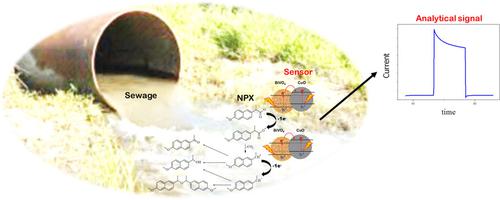当前位置:
X-MOL 学术
›
Electroanalysis
›
论文详情
Our official English website, www.x-mol.net, welcomes your
feedback! (Note: you will need to create a separate account there.)
Using Bismuth Vanadate/Copper Oxide Nanocomposite as Photoelectrochemical Sensor for Naproxen Determination in Sewage
Electroanalysis ( IF 2.7 ) Pub Date : 2020-05-06 , DOI: 10.1002/elan.202000055 Thiago M. Prado 1 , Carolina C. Badaró 1 , Rafaela G. Machado 1 , Pedro S. Fadini 1 , Orlando Fatibello‐Filho 1 , Fernando C. Moraes 1
Electroanalysis ( IF 2.7 ) Pub Date : 2020-05-06 , DOI: 10.1002/elan.202000055 Thiago M. Prado 1 , Carolina C. Badaró 1 , Rafaela G. Machado 1 , Pedro S. Fadini 1 , Orlando Fatibello‐Filho 1 , Fernando C. Moraes 1
Affiliation

|
Conventional sewage treatment plants are not usually designed to remove emerging contaminants, and this shortcoming leads to the discharge of pharmaceuticals, among other emerging pollutants, into the environment. The present work reports the development of BiVO4/CuO‐based photoelectrochemical sensor for the determination of naproxen in sewage samples. Morphological characterizations were carried out by X‐ray diffraction and Scanning electron microscopy. The band gap energy of the nanocomposite material was calculated by Tauc plots using the data obtained from diffuse reflectance spectroscopy analysis. The sensor presented analytical signal during the photocurrent generation simultaneously with the oxidation of naproxen on the working electrode. The sensor responses were found to be proportional to the increase in naproxen concentration in the linear range of 5 nmol L−1 to 480 nmol L−1, R2=0.996, with a limit of detection of 5 nmol L−1. The presence of naproxen in sewage samples was successfully determined with recovery percentages above 95 %.
中文翻译:

钒酸铋/氧化铜纳米复合材料作为光电化学传感器测定污水中萘普生的含量
传统的污水处理厂通常没有设计成去除新兴污染物的方法,这种缺点导致药物以及其他新兴污染物向环境的排放。本工作报告了BiVO 4的发展基于/ CuO的光电化学传感器,用于测定污水样品中的萘普生。形态表征是通过X射线衍射和扫描电子显微镜进行的。使用从漫反射光谱分析获得的数据,通过Tauc图来计算纳米复合材料的带隙能量。传感器在光电流产生期间提供分析信号,同时萘普生在工作电极上被氧化。发现传感器响应与萘普生浓度在5 nmol L -1至480 nmol L -1的线性范围内成正比,R 2 = 0.996,检出限为5 nmol L -1。成功地确定了污水样品中萘普生的存在,回收率高于95%。
更新日期:2020-05-06
中文翻译:

钒酸铋/氧化铜纳米复合材料作为光电化学传感器测定污水中萘普生的含量
传统的污水处理厂通常没有设计成去除新兴污染物的方法,这种缺点导致药物以及其他新兴污染物向环境的排放。本工作报告了BiVO 4的发展基于/ CuO的光电化学传感器,用于测定污水样品中的萘普生。形态表征是通过X射线衍射和扫描电子显微镜进行的。使用从漫反射光谱分析获得的数据,通过Tauc图来计算纳米复合材料的带隙能量。传感器在光电流产生期间提供分析信号,同时萘普生在工作电极上被氧化。发现传感器响应与萘普生浓度在5 nmol L -1至480 nmol L -1的线性范围内成正比,R 2 = 0.996,检出限为5 nmol L -1。成功地确定了污水样品中萘普生的存在,回收率高于95%。











































 京公网安备 11010802027423号
京公网安备 11010802027423号